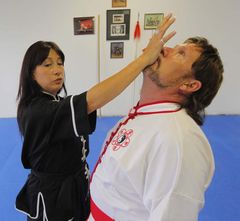
Self-defence course teaches women to overcome their need to be nice

Sifu Peggy McRitchie teaches a women's self-defence course out of the new location of Plum Blossem Martial Arts Academy on Pembina Highway. (BORIS MINKEVICH / WINNIPEG FREE PRESS)
Targets & tactics
As obvious as it may seem, testicles should not be the first anatomical target when fighting off an attacker, according to Winnipeg martial arts expert Peggy McRitchie. "Men are smart, they know that's their most vulnerable area and they'll protect it," she says.
The best targets for a self-defensive strike are the upper lip and bridge of the nose, the windpipe (hollow of the throat), ears and eyes. Regarding the latter, the best strategy is "flick and run."
Never face an attacker square on. Take a side stance, where you're more grounded and better able to pivot. "Always protect your inside circle," says McRitchie. "That's where your vital organs are."
Since women typically have smaller and more delicate hands, use an open hand instead of a fist for striking techniques
If someone grabs you by the wrist, don't try to pull away, as it'll only make them pull harder in return. Instead, use your thumbnail to dig into the would-be assailant's fingernail bed, near the cuticle.
If going for the ears, strike with a cupped hand, which creates a vacuum that can rupture the eardrum of an attacker.
Contrary to popular belief, the best defence is not always a strong offence -- at least for women trying to protect themselves against violence.
"Combat is the last resort," says Winnipeg martial arts instructor Peggy McRitchie. According to her ABCs of self-defence, "awareness" and "boundaries" come first.
That means paying close attention to your environment -- which you can't do if you're texting or listening to your iPod -- and maintaining your personal space.
And if someone with ill intentions invades that space? No more Ms. Nice Guy.
McRitchie, 52, who has a black belt in a style of kung fu known as choy li fut, has some basic techniques that any woman can learn in order to thwart a would-be attacker and empower herself. They have names like "tiger claw."
McRitchie and her daughter, Chantal -- who have a combined 35 years of martial arts training between them -- will be teaching that and other self-defence skills in a one-day workshop on Sunday. It runs 11 a.m. to 3 p.m. at the University of Winnipeg's Richardson College for the Environment & Science Complex (599 Portage Ave.). Cost is $49 per person. Register online (www.plumblossom.ca) or by calling 204-791-6146.
Choy li fut, which McRitchie learned from her father as a child, is a traditional style of kung fu that combines intricate arm and hand techniques from southern China with the agile footwork that characterizes northern Chinese martial arts. It's considered one of the most effective self-defence systems, and was supposedly praised by Bruce Lee as one of the most difficult styles to attack and defend against.
Participants at Sunday's workshop will initially practise the techniques on each other in small groups. Then, in the second half, trained male instructors will don safety gear and play the role of assailants.
"The women will get to experience the feeling of what it's actually like to hit and not hold back," as they might in an all-female workshop, says McRitchie.
The retired nurse and owner of Plum Blossom Martial Arts Academy, which just moved into new digs on Pembina Highway, has been teaching choy li fut to children and adults since 1982, but only started offering women's self-defence classes after she herself was attacked when she was in her late 20s.
She was walking home from her waitressing job in downtown Winnipeg around 4 p.m. and cut through a restaurant parking lot when a man jumped her in the back lane. He grabbed her by the hair, dragged her between two cars and was on top of her before she knew what was happening.
"It was fast and aggressive. It came out of nowhere," McRitchie recalls. "All I can remember thinking is, 'It's him or me.'"
Thanks to years of kung fu training, her fighting instinct kicked in and her attacker ended up running off with a bloodied face. But most women, she says, don't have that instinct. "Statistics show that women in these situations tend to freeze."
Corinne Paulishyn, who has studied choy li fut for five years, isn't surprised. "As women, we're taught not to fight," says the social worker, who has taken McRitchie's self-defence course several times. "We're taught to be nice and not hurt anybody."
Social conditioning can leave women vulnerable to stranger violence, McRitchie says, for the simple reason that they're less likely than men to enforce their personal boundaries. But owning your personal space, she adds, is crucial to avoid giving off a victim vibe or looking like an easy target.
Remaining vigilant and constantly scanning one's environment is key to the awareness piece, says McRitchie. Reflecting on her own attack, she says she shouldn't have cut through the parking lot, where her presence -- and that of her assailant -- was obscured by rows of cars.
Not that witnesses to violence are guaranteed to intervene. Nor are all the perpetrators men, of course.
Years ago, McRitchie's daughter and her friend were attacked by a gang of girls outside a mall while bystanders did nothing.
"You're responsible for your own self-defence. You can't rely on the car driving by or the person walking by to come to your rescue," McRitchie says.
And while fighting violence with violence is the last resort, if you're attacked, "The No. 1 rule is you need to do something," she says. "Doing nothing is basically giving up. You have to come with the mentality that it's either him or you."
[email protected]
Republished from the Winnipeg Free Press print edition July 16, 2013 D1